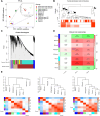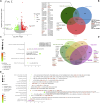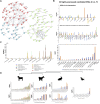Transcriptome meta-analysis reveals the hair genetic rules in six animal breeds and genes associated with wool fineness
- PMID: 38948362
- PMCID: PMC11211574
- DOI: 10.3389/fgene.2024.1401369
Transcriptome meta-analysis reveals the hair genetic rules in six animal breeds and genes associated with wool fineness
Abstract
Wool plays an irreplaceable role in the lives of livestock and the textile industry. The variety of hair quality and shape leads to the diversity of its functions and applications, and the finer wool has a higher economic value. In this study, 10 coarse and 10 fine ordos fine wool sheep skin samples were collected for RNA-seq, and coarse and fine skin/hair follicle RNA-seq datasets of other five animal breeds were obtained from NCBI. Weighted gene co-expression network analysis showed that the common genes were clustered into eight modules. Similar gene expression patterns in sheep and rabbits with the same wool types, different gene expression patterns in animal species with different hair types, and brown modules were significantly correlated with species and breeds. GO and KEGG enrichment analyses showed that, most genes in the brown module associated with hair follicle development. Hence, gene expression patterns in skin tissues may determine hair morphology in animal. The analysis of differentially expressed genes revealed that 32 highly expressed candidate genes associated with the wool fineness of Ordos fine wool sheep. Among them, KAZALD1 (grey module), MYOC (brown module), C1QTNF6 (brown module), FOS (tan module), ITGAM, MX2, MX1, and IFI6 genes have been reported to be involved in the regulation of the hair follicle cycle or hair loss. Additionally, 12 genes, including KAZALD1, MYOC, C1QTNF6, and FOS, are differentially expressed across various animal breeds and species. The above results suggest that different sheep breeds share a similar molecular regulatory basis of wool fineness. Finally, the study provides a theoretical reference for molecular breeding of sheep breeds as well as for the investigation of the origin and evolution of animal hair.
Keywords: Ordos fine wool sheep; WGCNA; meta-analysis; six livestock breeds; wool fineness.
Copyright © 2024 Pu, Ma, Zhao, Tang, Lu, Liu, Wang, Cen, Wu and Fu.
Conflict of interest statement
The authors declare that the research was conducted in the absence of any commercial or financial relationships that could be construed as a potential conflict of interest.
Figures




References
LinkOut - more resources
Full Text Sources
Research Materials

